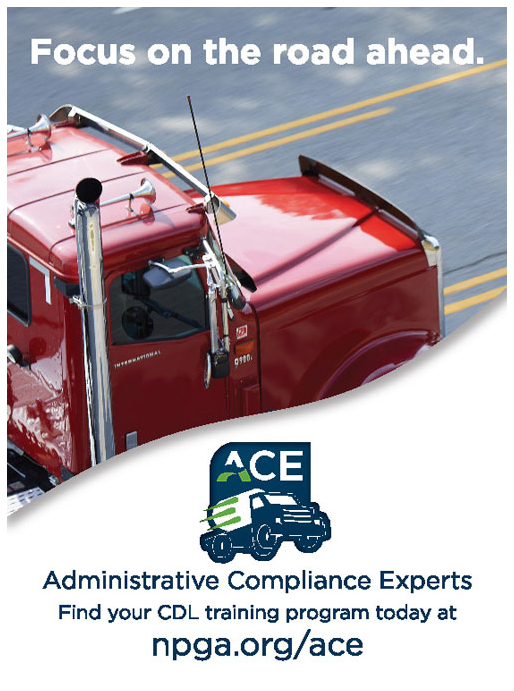
On Feb. 7, 2022, the Federal Motor Carrier Safety Administration’s (FMCSA) Entry-Level Driver Training (ELDT) mandate goes into effect. The mandate includes a set of training requirements all commercial driver’s license (CDL) training providers must abide by before qualifying drivers. Whew — enough acronyms for you?
The goal of the mandate is to decrease the number of accidents caused by new and only partially trained drivers on the roads. Through the mandate, the FMCSA also hopes to establish a benchmark for training for commercial driving, no matter the industry or vocation. The downside of the mandate, though, is that the federal standards create a lengthier, (and potentially more difficult) process for propane marketers and others allied to the industry to train new delivery drivers, service employees, fuel haulers and more.
Who is considered an entry-level driver, you ask? All individuals applying to the following must go through the entry-level driver training:
- Obtain a Class A CDL or Class B CDL for the first time
- Upgrade an existing Class B license to a Class A CDL
- Obtain a school bus (S), passenger (P), or hazardous materials (H) endorsement for the first time
The new requirements are not retroactive — individuals issued a CDL and any additional endorsements prior to Feb. 7, 2022, are not required to undergo training. The mandate requires students to complete two types of training: classroom training and behind-the-wheel training, both in the field and on the road. The student must score at least 80% correct on the assessment to qualify.
Prior to taking the CDL exam, the student must also have a training provider certify them as “proficient” in the CDL skills curriculum. The student must provide documentation of the hours completed during the behind-the-wheel training portion of the curriculum.
There are only a few circumstances in which the mandate does not apply to new drivers. According to the FMCSA website, these are the following (visit the website for more information):
- Individuals applying under 383.3(c), (d) or (h)
- Individuals applying for a restricted CDL under 383.3(e) through (g)
- Military personnel who meet all requirements and conditions of 383.77
- Individuals applying for a removal of a restriction in accordance with 383.135(b)(7)
The FMCSA has built a website, which will go live on Feb. 7 with the mandate, that contains the official list of all entities that register with the FMCSA and self-certify they meet the requirements for being an entry-level driver training provider. The website will also retain a record of which drivers have successfully completed entry-level driver training.
With all the above in mind, the National Propane Gas Association (NPGA) has created ACE — Administrative Compliance Experts — a compliance service aimed at alleviating the burden on propane marketers and other companies in need of qualified drivers. But the origins of the ACE service go back to the early days of the mandate’s journey to fruition.
“During the rulemaking process, we were successful in advocating against several proposals that would’ve increased the hurdles to new drivers even more, but we wanted to expand our services to the industry,” said NPGA President and CEO Steve Kaminski. “So shortly after the ELDT regulations were finalized in 2016, the NPGA team began brainstorming how we could help our members navigate the regulatory requirements. Over the last few years, we’ve been working to leverage NPGA’s regulatory expertise with the Propane Education & Research Council’s (PERC) educational platforms and resources.”

While the service is designed to walk any company in need of trained, compliant drivers through the mandated process, the ACE service was designed specifically with propane marketers and suppliers in mind. Kaminski said NPGA and PERC developed the ELDT instructional materials so propane marketers could rest assured that it meets the specific needs and nuances of the industry.
“Using NPGA’s ACE service cuts all of the red tape — from registering with FMCSA to generating curriculum components, records and meeting administration timelines. And it’s less expensive for NPGA members than traditional brick-and-mortar driving schools, and more efficient,” he said.
NPGA’s ACE service boils down to five simple steps:
- Sign up online at npga.org
- Online knowledge training
- On-site, behind-the-wheel training
- Submit to NPGA
- CDL test
One of the strengths of the ACE service is that it simplifies the 30-plus steps required by the new mandate down to these few simple steps, according to Sarah Reboli, senior director, regulatory affairs at NPGA.
“The sheer volume and depth of the steps is difficult for propane marketers. These are a new series of steps required after a new driver obtains a learner’s permit but before the CDL testing itself. It’s like inserting a new alphabet between E and Z,” she said.
Kaminski and Reboli both noted that the service has been designed in a way to make the entire training-to-testing component a more efficient — and hopefully shorter — process for the trainee, too. “A fantastic feature of what we’ve developed is that it melds to the needs and aptitude of the applicant. A driver applicant with years of experience operating farming equipment is going to move through the material faster than an applicant entirely unfamiliar with commercial driving,” Reboli said. “Overall we estimate that the average learner can complete the training requirements successfully in less than three weeks, which is a third of the typical time for a traditional brick-and-mortar school.”
The mandate divides training requirements into two basic parts — classroom training and behind-the-wheel training. During the classroom, or theory, training, applicants may use a simulator and must score the aforementioned 80% on the assessment, but there is no minimum of hours required. Training topics include basic operation, safe operating procedures, and vehicle systems and reporting malfunctions. During behind-the-wheel training, applicants must practice actual operation of a commercial vehicle — and they may not use a simulator to meet training requirements.
This training must take place on a range and a public road. There is no minimum of hours in this portion either; a training provider will determine the driver’s proficiency. The applicant will accomplish learning basic vehicle control skills and proficiency in basic maneuvers during this part.
The ACE service offers online theory training (the classroom component) to its trainees. NPGA coordinated with PERC to produce theory materials for video-based training that can be completed anywhere with a computer. Training for the HAZMAT endorsement (HME) is included with the service as an optional portion.
According to Reboli, the team developed behind-the-wheel checklists and forms for propane marketers to execute behind-the-wheel training that complies with the required teaching under the terms of the regulations. Behind-the-wheel training can be completed by an individual on the marketer’s staff with an active CDL.
NPGA’s ACE service steps in to make sure everything is completed properly and moves in a timely manner. Reboli said there are small timelines and details in the regulations that could undermine a marketer’s best efforts to comply — which is where the ACE service can help in tracking and paying attention to impending deadlines.
While the team estimates a much shorter timeline from training to qualification, the training can be completed over a period of 12 months.
By working with the ACE service, the marketer also bypasses the need to become a registered training provider through the FMCSA. And after the applicant has taken their CDL test, passed, and become a qualified driver, full enrollment in the ACE service also affords the propane marketer protection from federal audits by the FMCSA. Marketers can use the program training materials without the use of ACE.
However, by opting in for ACE as well, it also means that it is NPGA records that are subject to an audit, without burden or interruption to the routine operations of the marketer, Reboli said. In short, NPGA will navigate the regulatory and compliance details so marketers can focus on qualifying drivers and getting them on the road.
The NPGA team first announced the opening of a waiting list for the ACE service to the propane industry in October 2021 at the NPGA Southeastern Convention & International Propane Expo.
“Given the timing of the start date and the natural seasonal work for the propane industry, we anticipate a gradual build-up of marketers searching for and enrolling new driver applicants into the ACE services as we move through spring and into summer,” Reboli said.
You can find a breakdown of fees — one for association members and one for the general public — on the NPGA website, as well as a decision tree that helps identify ACE service options and price points. Kaminski said the feedback regarding the program has been overwhelmingly positive.
“While additional regulations are a burden, the propane industry is breathing a sigh of relief that this service is available,” Kaminski said. “In addition, numerous other industries have contacted NPGA about having their members use the ACE service. Recognizing the complexities of going it alone and the depth and breadth of ACE, these industries are sending their members to ACE as a one-stop-shop for compliance.”
Want to know more about ACE? Visit the NPGA website to find out more about the service and register your team members for training. Have specific questions about the ACE service? Contact NPGA at eldt@npga.org.


